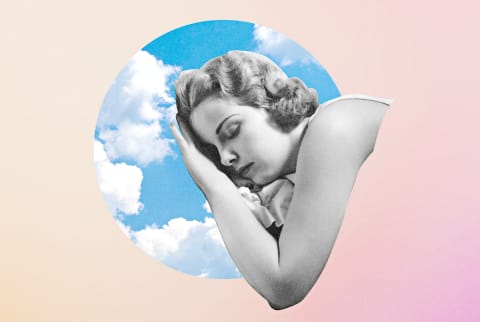What To Do Before & After Daylight Saving To Make Sure It Doesn't Mess With Your Sleep


Brighter days are ahead: In the wee hours of the morning on Sunday, March 10, American clocks will jump forward an hour. While the shift will lead to lighter skies later in the day, it might not do such sunny things to our health.
Studies show that most people lose between 40 and 60 minutes of sleep1 in the night that we turn the clock. That might not sound like such a big deal, but population-wide data has found that the rate of heart attacks, strokes2, and mood disorders in the U.S. temporarily increases following the spring forward. On a personal level, the sleep loss can leave people feeling groggy, irritable, and hungry for junk food. (Funnily enough, once upon a time, Idaho potato supporters lobbied for daylight saving time [DST] because they saw that the fast-food industry sold so many more french fries after it hit.)
"One hour is enough to make a difference," sleep researcher Rebecca Robbins, Ph.D., says. But, she adds, we don't necessarily need to resign to heading into spring feeling sleepy. "Here's what you do: Start preparing about a week in advance [...] try to really make sleep your priority, now more than ever."
Wendy M. Troxel, Ph.D., clinical psychologist and author of Sharing the Covers: Every Couple's Guide to Better Sleep, agrees that starting to prioritize your sleep about a week before daylight saving (so, right now!) can help you spring forward with ease. Here's how it's done, according to the two sleep experts:
What to do before the clocks change:
Back up your sleep schedule by around 15 minutes every night leading up to next weekend.
The best way to ensure that daylight saving doesn't catch you off guard is to get ahead of it. If you're already in the routine of going to bed (and waking up) an hour earlier than usual by next weekend, the time difference shouldn't affect you too much.
Troxel warns that it's difficult to shift your sleep-wake schedule by an hour3 all at once, so she recommends taking it slow: This week, aim to go to bed 15 minutes earlier every night until you get to that hour mark, then stay there.
Make sleep more of a priority this week.
Again, the name of the game is getting your sleep routine in tip-top shape before next weekend. "It's really important that we don't start out with accumulated sleep debt, as this will make the consequences of losing sleep even greater," Troxel explains.
So if there was a week to pull out all the sleep stops, Robbins says this is the one. Be a little bit more religious than usual about your bedtime, lay off the caffeine, avoid post-dinner booze and sugar, and stop looking at electronics right before bed.
What to do after the clocks change:
Get outside as much as possible during the day, especially in the morning.
Feeling the sun on your skin first thing in the morning will help your body's circadian clock, or internal rhythm, acclimate to its new schedule.
Keep your home extra dark at night.
Conversely, limiting your exposure to lights at night can help your body get used to this time adjustment. Next week, make a point to turn any bright lights in your home off once the sun sets (now's as good a time as any to invest in some candles or circadian-friendly lightbulbs) and power down electronics at least an hour before bed to tell the brain that it's time to get ready for sleep.
Be gentle with yourself—and your sleep partner.
And finally, remember that even if your DST prep doesn't go as planned, you will get your sleep back on schedule eventually. Allow yourself a little extra grace in the meantime.
And if you share the bed with someone, extend them the same courtesy. Troxel, who specializes in how sleep disorders affect couples, has seen that DST can cause temporary rifts in relationships—especially if one person is a night owl and has trouble adjusting to the earlier schedule.
"We're more irritable, more prone to conflict, and less empathetic when sleep-deprived, so if you or your partner is a bit on edge in the days following DST, practice some patience and acceptance," she recommends.
The takeaway
The March cycle of daylight saving time tends to lead to shorter sleep (and the grogginess and moodiness that comes with it). Moving your bedtime and wake-up time up 15 minutes a night this week can help you get through it feeling great. And next week, keeping the lights down low at night and getting outside in the mornings will keep your mood up as we spring forward into a lighter, brighter season.